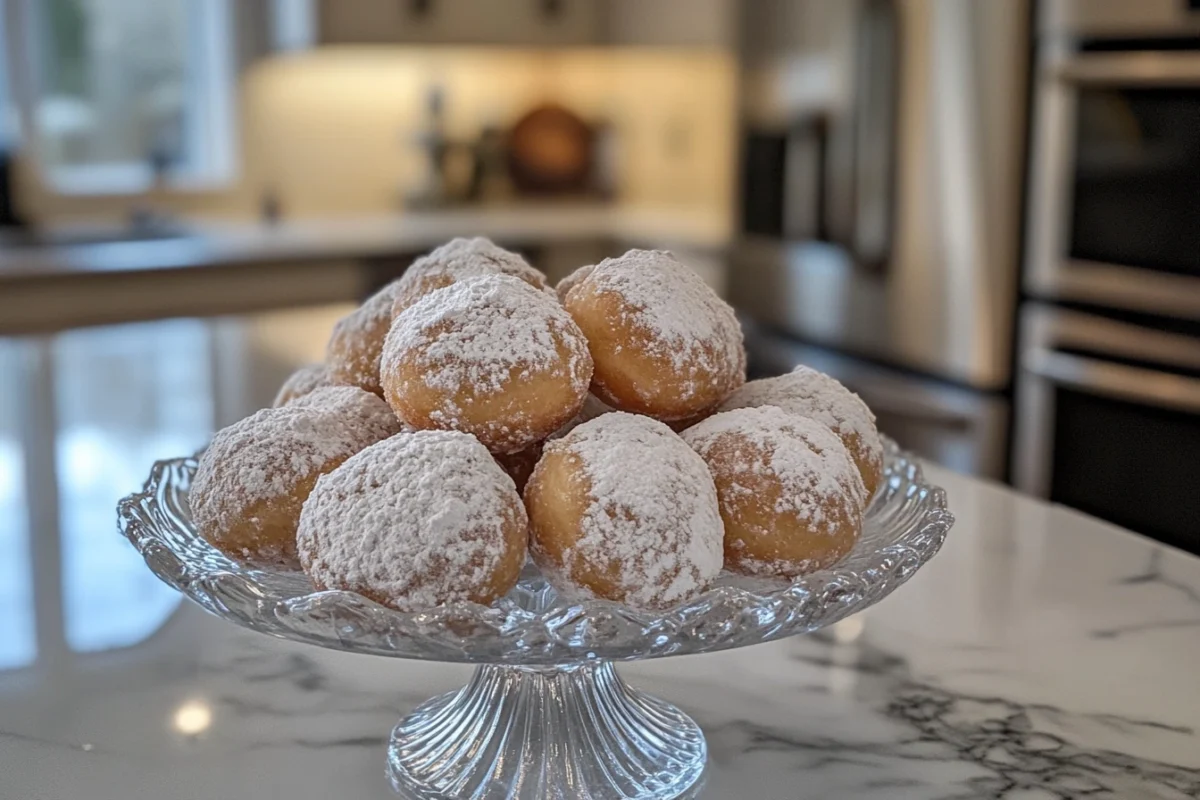This article explores whether yeast or baking powder is naturally better for making delicious donuts. Learn the key differences for the best results.
The Great Donut Debate: Yeast vs. Baking Powder
Making naturally delicious donuts involves understanding your leavening choices. Two main contenders are yeast and baking powder. Each affects the texture and flavor significantly. This article will explore these differences. We’ll help you choose the best option for your baking needs. Furthermore, we’ll delve into the nuances of each. Understanding these nuances will make your donuts extraordinary.
If you’re looking to make a quick donut recipe that doesn’t require the waiting time for dough to rise, baking powder might be your best bet.
Understanding Yeast in Doughnuts
Naturally Leavened Dough: The Power of Yeast
Yeast is a living organism. Naturally, it produces carbon dioxide. This gas is what makes dough rise. It creates the airy, light texture we love in many baked goods. Doughnuts made with yeast need time to proof. This process develops their distinct flavor. This deeper flavor is a key element of naturally good donuts. Additionally, the slow fermentation contributes to a richer taste profile. Therefore, using yeast brings a depth of flavor that is hard to replicate.
Types of Yeast for Doughnuts
There are mainly two types: active dry yeast and instant yeast. Active dry yeast needs to be bloomed in warm water. This rehydrates the yeast and gets it ready to work. Instant yeast, on the other hand, can be added directly to the dry ingredients. Both work well for donut dough. However, instant yeast saves a bit of time. This is a naturally convenient choice for busy bakers. Moreover, it provides consistent results and is easier to use. Consequently, many bakers now prefer instant yeast due to its convenience.
How Yeast Affects Donut Texture
Yeast naturally creates a light, airy crumb. It also contributes to a slightly chewy texture. This is different from the cakey donuts made with baking powder. The slow rise allows gluten to develop. The result is a more complex flavor and a tender crumb. Therefore, yeast produces a classic donut texture. This texture is what many associate with a traditional donut experience. Additionally, the gluten development adds structure and helps hold the shape of the donuts.
The Importance of Proofing Temperature
The temperature of your proofing environment is also vital. A warm, draft-free spot is best. A slightly warm oven, or a proofing box, works well. This promotes the yeast activity and ensures the dough rises properly. Therefore, temperature control is an essential part of using yeast successfully. Consequently, proper temperature management will result in a lighter donut with an enhanced flavor.
Baking Powder and Its Role in Doughnuts
The Chemical Leavener: Baking Powder
Baking powder is a chemical leavening agent. Unlike yeast, it doesn’t require a proofing period. It produces carbon dioxide when mixed with liquids and heat. This causes the dough to rise quickly. This quick rise is ideal for recipes where time is of the essence. Moreover, it is a naturally convenient way to make donuts fast. Consequently, it is a great option when you want a quick donut.
Double-Acting Baking Powder
Most baking powders used today are double-acting. This means they release some gas when wet. Then, they release more gas when heated. This double-action ensures the dough rises properly. It provides a consistent result in your recipes. Therefore, you get a naturally fluffy donut. Additionally, the double-action allows for some flexibility in the baking process. This ensures good results even if the batter sits for a little while.
Baking Powder and Donut Texture
Donuts made with baking powder have a cake-like texture. They are usually denser and more tender than yeast donuts. They lack the chewiness. These donuts are perfect for those who prefer a soft, less airy bite. This is an important factor, especially when you want to achieve a naturally tender texture. Furthermore, the denser texture makes them a bit more filling. Consequently, you will have a different eating experience than yeast-based donuts.
Baking Powder’s Shelf Life
Baking powder does lose its effectiveness over time. So it is good to keep it in a cool, dry place and replace it if you’ve had it for more than six months. Using fresh baking powder ensures that your donuts rise properly and get the texture you are looking for. Therefore, paying attention to the freshness of your baking powder is an important step. Consequently, old baking powder can cause your donuts to be dense and flat.
Key Differences: Yeast vs. Baking Powder for Donuts
Flavor Profiles Compared
Yeast naturally creates a complex, slightly tangy flavor. This develops during the fermentation process. Baking powder, however, offers a more neutral flavor. The difference significantly impacts the overall taste. If you want a rich flavor, choose yeast. Conversely, if you prefer a simpler taste, go with baking powder. Therefore, flavor is a major factor. Furthermore, yeast’s flavor is due to the byproducts of fermentation, while baking powder does not provide any additional flavor notes. Consequently, the difference in flavor is significant.
Texture: What to Expect
Yeast donuts are light, airy, and slightly chewy. They have a classic, raised dough texture. Baking powder donuts are cakey and tender. They are much closer to a cake in texture. Texture is a vital element. This helps you decide which leavening agent is best. Consequently, the final product is drastically different. Therefore, this is a crucial factor when planning your baking project.
Time Investment and Ease of Use
Yeast donuts require more time. They need proofing and development. Baking powder donuts are quicker to make. There is no need for proofing. This makes them a fast, convenient option. Therefore, the time factor is a significant aspect. Choose based on how much time you can dedicate to baking. Furthermore, yeast requires more attention and planning. Consequently, baking powder is a better fit for spontaneous baking.
Naturally Occurring Reactions
Yeast relies on naturally occurring fermentation. This results in a slower, more flavorful rise. Baking powder, however, is a chemical process. Therefore, it creates an immediate reaction. The type of reaction significantly impacts the final result. Choose the method that suits your desired outcome. Additionally, yeast’s slow fermentation allows for more flavor development. Therefore, each reaction provides distinct characteristics.
Choosing the Right Leavener for Your Donuts
Consider Your Time Constraints
If you have plenty of time, use yeast. It creates superior flavor. If you’re in a hurry, choose baking powder. It gives you a fast and reliable result. Consider your schedule. Then, you can select the naturally appropriate leavening method. Moreover, planning is important. Subsequently, the results will be much better if you take your time.
Desired Texture and Flavor
If you want classic, light, chewy donuts, use yeast. If you prefer cakey and tender donuts, use baking powder. Think about your taste preferences. Ultimately, you will pick the best option for your palate. Naturally, the choice depends on what you prefer. Furthermore, consider what kind of eating experience you would like. Consequently, the texture and flavor are the main factors in your choice.
The Type of Donut You’re Making
For traditional raised donuts, yeast is the preferred choice. For cake donuts, baking powder is often used. Understanding the desired result matters greatly. This ensures the best outcome based on the specific recipe. Consequently, you will get the best tasting donuts. Moreover, some recipes simply do not work well with the wrong leavening method.
Naturally Enhancing Flavor
Sometimes, a combination of both yeast and baking powder can be used. This blend enhances both flavor and texture. Experimenting with different techniques might be worthwhile. Therefore, blending both can provide unique results. Furthermore, using a small amount of both can help you get a softer texture. The best approach is to experiment to find your preference. Consequently, you can personalize your recipes with your own preferred methods.
Techniques for Using Yeast in Donut Dough
Activating the Yeast Correctly
Make sure the water is warm, not hot. Too hot, and you will kill the yeast. Then, let the yeast bloom for about 5-10 minutes. This will ensure it is active and ready to use. Therefore, activating yeast correctly is crucial for success. This step ensures your dough rises well. Furthermore, using a thermometer can help you ensure you have the right water temperature. Consequently, proper activation ensures your yeast is working effectively.
Proper Proofing Techniques
Cover the dough and allow it to rise in a warm place. The rise time may vary depending on the temperature. Usually, it takes about 1-2 hours. The dough should double in size. Proofing properly is key. It allows the yeast to work its magic. This stage develops the flavor, giving you a naturally delicious donut. Moreover, patience is key to a successful proof. Subsequently, proper proofing is essential for a light and airy final product.
Working with Yeast Dough
Yeast dough can be a bit sticky. Use a lightly floured surface. Also, use a bench scraper. This will make the process more manageable. Work gently with the dough. Avoid over-kneading it. Proper techniques will make your experience better. Subsequently, your end product will be better. Furthermore, over-kneading can result in a dense texture. Therefore, handle the dough gently.
First Proof and Second Proof
Some recipes call for a first proof after the initial mixing and kneading. After shaping the donuts, there is a second proof before frying or baking. These proofs are vital for the dough development. They ensure a light and airy texture. Therefore, be sure to plan for enough proofing time. This is an important part of the process.
Techniques for Using Baking Powder in Donut Dough
Combining Baking Powder with Other Dry Ingredients
Mix baking powder with flour, sugar, and spices. This ensures it is evenly distributed. An even mix is essential for uniform rising. Therefore, this method helps make sure each donut rises evenly. This is a simple step, but it is extremely important. Furthermore, sifting the dry ingredients can ensure they are completely mixed. Consequently, a consistent mixture results in a uniform texture.
Adding Wet Ingredients to the Dry Mix
Add wet ingredients, such as milk, eggs, and melted butter. Mix until just combined. Do not overmix. Overmixing will result in tough donuts. Accordingly, you should only mix until the ingredients are combined. Do not overdo it. Furthermore, gentle mixing is essential to get a tender crumb. Consequently, overmixing leads to too much gluten development, resulting in a dense donut.
Frying or Baking the Donuts
Baking powder donuts can be either fried or baked. Frying creates a crisp crust and a tender interior. Baking results in a lighter, softer donut. The cooking method affects the texture significantly. Thus, choose the method that suits your texture preference. Moreover, the way you cook the donuts determines the final result. Therefore, choose wisely to achieve your desired texture.
Temperature Control During Cooking
The temperature of your frying oil or oven must be appropriate. Use a thermometer. This ensures the donuts cook properly. It helps prevent them from being burnt or undercooked. Temperature control is very important for good results. Therefore, pay close attention to your cooking temperatures.
Health Considerations: Yeast vs. Baking Powder
Nutritional Value of Yeast
Yeast is a good source of B vitamins. However, the amount in donuts is not significant. Yeast also provides some minerals. Naturally, it is low in calories. It can be part of a balanced diet. Moreover, yeast offers some benefits. Additionally, it contains trace minerals. Furthermore, the nutrients it provides are not substantial in the quantities used in donuts.
Nutritional Value of Baking Powder
Baking powder itself does not provide significant nutritional value. However, it plays a role in making recipes lighter. Therefore, it affects the nutritional profile indirectly. Consequently, it makes baked goods more palatable. Furthermore, baking powder has no significant nutrients. Thus, its role is purely as a leavening agent.
Overall Health Impact
The overall health impact of donuts depends on other factors. This includes the amounts of sugar and fat. Enjoy them in moderation. Choose recipes with whole grains when you can. Consequently, you should make conscious dietary choices. Therefore, balance your treat consumption. Moreover, it is important to enjoy donuts as part of a varied diet. Subsequently, moderation is key when enjoying them.
Considerations for Specific Diets
People on gluten-free or low-carb diets must be mindful of the ingredients in the recipe. Choose alternative flours, accordingly. Modify the recipes as needed. Naturally, you can still enjoy donuts while adhering to dietary restrictions. Therefore, look for modified recipes that fit your particular needs. Furthermore, plenty of online resources can help you make dietary adjustments. Consequently, it is possible to adapt most recipes to your specific diet.
Troubleshooting Common Issues
Dough Not Rising Properly
Make sure your yeast is active and your water is warm. Proof your dough in a warm place. Follow the recipe exactly. This will help you achieve the best results. Moreover, it will help troubleshoot any potential issues. Thus, following instructions is extremely important. Furthermore, checking your ingredients expiration dates is vital for success.
Donuts Too Dense
Do not overmix the dough. Be gentle when working with it. Use the correct ratio of ingredients. Consequently, following precise recipes is beneficial. It results in a good, fluffy donut. Therefore, remember not to over mix the dough. Additionally, the correct leavening agent and proper dough handling are key. Subsequently, gentle handling ensures the gluten does not over-develop.
Donuts Too Dry
Make sure you use enough liquid in the recipe. Don’t over bake. Consider adding a little bit of oil to the dough. It can help keep them moist. Consequently, this helps solve common issues. Therefore, keep your donuts moist. Furthermore, ensuring the cooking temperature is accurate is important. This will keep the donuts from drying out quickly.
Achieving the Right Level of Naturally Sweetness
The sweetness of the dough can be adjusted according to your taste. Adjust the amount of sugar. Consider using sweeteners. This can help you customize the recipe to your preference. Naturally, you can experiment with different levels of sweetness. Therefore, adjust the recipes as needed. Furthermore, different sweeteners have varying levels of sweetness. So, adjust accordingly.
Frequently Asked Questions (FAQs)
Is yeast or baking powder better for donuts?
Yeast results in a light, chewy donut. Baking powder yields a cakey donut. The “better” choice depends on personal preference. Additionally, it depends on the specific flavor and texture that you are aiming for.
Can you use both yeast and baking powder in donuts?
Yes, some recipes use both. This can create a unique texture and flavor. However, it’s not necessary for most recipes. Furthermore, this is an advanced baking technique. It requires some experience to master properly.
What makes a donut fluffy?
A good rise is essential for fluffy donuts. With yeast, ensure proper proofing. With baking powder, ensure proper mixing. Additionally, using fresh ingredients is crucial. Consequently, the quality of ingredients impacts the final product.
Can I make donuts without yeast?
Yes, baking powder is a good alternative. It creates cakey donuts. They are a quick and easy option. Moreover, they do not require the same amount of time and planning. Furthermore, baking powder is an excellent way to make donuts when you don’t have yeast on hand.
Conclusion: Making the Right Choice
Both yeast and baking powder create delicious donuts. However, they produce very different textures and flavor. Naturally, the choice between the two depends on your personal preference. Consider your time, skills, and the type of donut you’re making. Then, you can make the best decision for your needs. Whether you choose yeast or baking powder, enjoy the baking process. Therefore, have fun making homemade donuts. Moreover, the best way to find your preference is through experience and experimentation. Ultimately, the best donuts are the ones that you love to make and eat.
If you’re in the mood for a quicker breakfast or snack, mini pancakes could offer similar satisfaction to cake donuts without the lengthy wait time.




